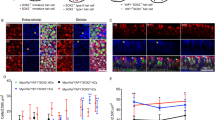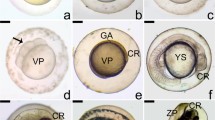Abstract
Formation of the otocyst from the otic placode appears to differ from invagination of other cup-shaped organ primordia. It is known that the cellular cytoskeleton plays a limited role in otic placode invagination, whilst the extracellular matrix underlying the otic primordium intervenes in the folding process. In this study we have analysed the role of the basal lamina heparan sulphate proteoglycan in otic primordium invagination. At 10 H.H. stage, heparan sulphate proteoglycan immunomarking begins to appear on the otic placode basal lamina, increasing noticeably at 13 H.H. stage, coinciding with maximum folding of the otic epithelium, and is still present at later stages. Enzyme degradation of heparan sulphate proteoglycan in the otic primordium basal lamina, by means of microinjection with heparinase III prior to folding, significantly disrupts invagination of the otic placode, which remains practically flat, with a significant reduction in the depth of the otic pit and an increase in the diameter of the otic opening. The immunocytochemistry analysis revealed a notable depletion of basal lamina heparan sulphate proteoglycan in the otic primordia microinjected with heparinase, with no statistically significant differences observed in the volume or rate of cell proliferation in the otic epithelium relative to the control, which suggests that heparan sulphate proteoglycan disruption does not interfere with the epithelial growth. In addition, a study of apoptosis distribution by the TUNEL method confirmed that treatment with heparinase does not cause interference with cell survival in the otic epithelium. Our findings support the theory that otic primordium invagination may be regulated, at least in part, by the basal lamina components, which might contribute towards anchoring the otic epithelium to adjacent structures.
Similar content being viewed by others
Author information
Authors and Affiliations
Additional information
Accepted: 2 June 2000
Rights and permissions
About this article
Cite this article
Moro-Balbás, J., Gato, A., Alonso, M. et al. Basal lamina heparan sulphate proteoglycan is involved in otic placode invagination in chick embryos. Anat Embryol 202, 333–343 (2000). https://doi.org/10.1007/s004290000119
Issue Date:
DOI: https://doi.org/10.1007/s004290000119




